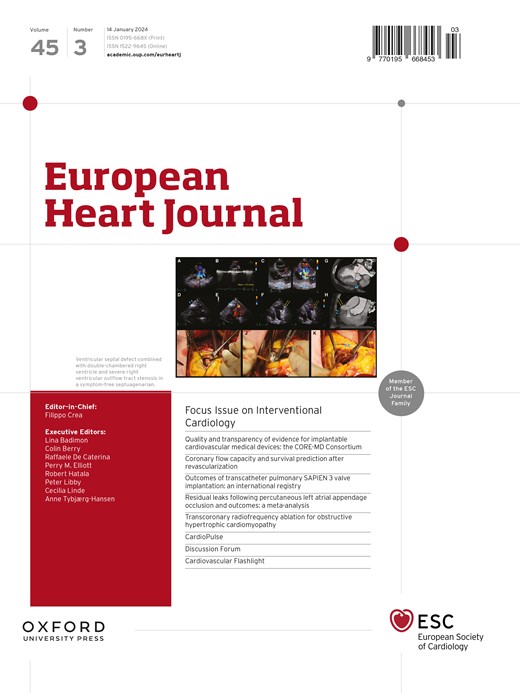Impact of a blood return system on mechanical thrombectomy in treatment of acute pulmonary embolism: a retrospective cohort study comparing 30-day mortality and need for blood transfusion
IF 37.6
1区 医学
Q1 CARDIAC & CARDIOVASCULAR SYSTEMS
引用次数: 0
Abstract
Background Mechanical thrombectomy (MT) has become an increasingly popular approach in treatment of pulmonary embolism (PE). Blood loss from aspiration is common during this procedure and can potentially limit clot extraction. A blood return system designed to be used during MT was introduced in January 2022; however, there is limited data demonstrating if its use has impacted mortality or need for blood transfusion in patients treated with MT. Purpose The aim of this study is to assess if there is a difference in outcomes amongst patients with acute PE that underwent MT with a blood return system vs. those that underwent MT without one. We hypothesize that MT with a blood return system will reduce mortality and need for post-procedure blood transfusions. Methods A large retrospective, multicentre database was used to identify patients diagnosed with PE that underwent MT. Patients were subsequently divided into two groups: 1) After and including January 2022, which was after the implementation of a blood return system vs. 2) Before January 2022, which was prior to the implementation of a blood return system. Student’s t-test was performed to compare baseline characteristics between the two cohorts. Propensity matching was performed based on relevant comorbidities and severity of PE estimated by PESI score parameters. Kaplan Meier curves were calculated to compare 30-day post-procedure mortality and need for blood transfusion. Results Patients that underwent MT after implementation of a blood return system (n= 2511) and before implementation of a blood return system (n= 2755) were propensity matched yielding 1915 patients per cohort. MT after implementation of a blood return system was associated with a decreased 30-day mortality compared to MT before implementation (6.99% vs 11.77% HR=0.602; 95% CI [0.486, 0.746], log-rank p<0.0001). Additionally, MT after implementation of a blood return system was associated with a decreased need for blood transfusion (7.52% vs 10.38%; HR=0.717; 95% CI [0.572, 0.898], log-rank p=0.0034). Conclusion MT after implementation of a blood return system was associated with a decreased risk of 30-day mortality and a lower likelihood of requiring blood transfusion when compared to MT prior to implementation of a blood return system.回血系统对治疗急性肺栓塞的机械取栓术的影响:比较 30 天死亡率和输血需求的回顾性队列研究
背景机械血栓切除术(MT)已成为治疗肺栓塞(PE)的一种日益流行的方法。在此过程中,抽吸造成的失血很常见,可能会限制血块的提取。2022 年 1 月推出了用于 MT 期间的血液回流系统;然而,关于该系统的使用是否会影响接受 MT 治疗患者的死亡率或输血需求的数据却很有限。目的 本研究旨在评估使用回血系统和不使用回血系统进行 MT 的急性 PE 患者的预后是否存在差异。我们假设,使用回血系统的 MT 可降低死亡率和术后输血需求。方法 使用大型回顾性多中心数据库来识别被诊断为 PE 并接受 MT 的患者。随后将患者分为两组:1)2022 年 1 月之后(含 2022 年 1 月),即实施回血系统之后;2)2022 年 1 月之前,即实施回血系统之前。对两组的基线特征进行了学生 t 检验。根据相关合并症和根据 PESI 评分参数估计的 PE 严重程度进行倾向匹配。计算卡普兰-梅耶尔曲线以比较术后 30 天的死亡率和输血需求。结果 对实施回血系统后(2511 人)和实施回血系统前(2755 人)接受 MT 的患者进行倾向匹配,每个队列有 1915 名患者。与实施前相比,实施血液回输系统后的 MT 可降低 30 天死亡率(6.99% vs 11.77% HR=0.602; 95% CI [0.486, 0.746], log-rank p<0.0001)。此外,实施血液回输系统后的 MT 与输血需求减少有关(7.52% vs 10.38%;HR=0.717;95% CI [0.572,0.898],log-rank p=0.0034)。结论 与实施血液回输系统前的 MT 相比,实施血液回输系统后的 MT 与 30 天死亡风险降低和需要输血的可能性降低相关。
本文章由计算机程序翻译,如有差异,请以英文原文为准。
求助全文
约1分钟内获得全文
求助全文
来源期刊

European Heart Journal
医学-心血管系统
CiteScore
39.30
自引率
6.90%
发文量
3942
审稿时长
1 months
期刊介绍:
The European Heart Journal is a renowned international journal that focuses on cardiovascular medicine. It is published weekly and is the official journal of the European Society of Cardiology. This peer-reviewed journal is committed to publishing high-quality clinical and scientific material pertaining to all aspects of cardiovascular medicine. It covers a diverse range of topics including research findings, technical evaluations, and reviews. Moreover, the journal serves as a platform for the exchange of information and discussions on various aspects of cardiovascular medicine, including educational matters.
In addition to original papers on cardiovascular medicine and surgery, the European Heart Journal also presents reviews, clinical perspectives, ESC Guidelines, and editorial articles that highlight recent advancements in cardiology. Additionally, the journal actively encourages readers to share their thoughts and opinions through correspondence.
 求助内容:
求助内容: 应助结果提醒方式:
应助结果提醒方式:


